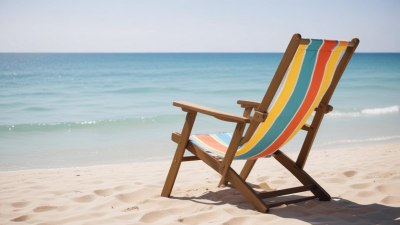The Hidden Truth About Beach Chairs: They Will Sink the Moment You Sit in Them
Discover the unexpected truth about beach chairs and why they sink when you sit down. Learn more in our detailed exploration.

This image was created with the assistance of Freepik
When you think of a day at the beach, the image that often comes to mind is that of sunbathing, enjoying the waves, or taking a leisurely stroll along the shore. A quintessential part of this beach experience is the beach chair. These portable seats provide comfort, support, and a place to relax amidst the sun and sand. However, unbeknownst to many, beach chairs possess a hidden truth: they have a tendency to sink the moment you sit in them. This curious phenomenon is not just a quirky trait; it reveals a lot about their design, materials, and the very nature of sand. In this article, we will explore the reasons behind this sinking sensation, the physics at play, and some tips on how to mitigate the sinking of beach chairs.
Beach chairs are often designed with portability and ease of use in mind. Lightweight materials such as aluminum or plastic are utilized to ensure that the chair can be easily transported. The structure of these chairs usually includes a folding mechanism that allows for compact storage. While these characteristics are beneficial for mobility, they also contribute to the chair's instability when placed on sand. The moment you sit down, your weight alters the distribution of pressure on the chair, causing it to perforate the surface of the sand beneath. This is particularly evident on loose or wet sand, where the weight of one person can destabilize the chair's support structure.
Understanding Sand Dynamics
To fully understand why beach chairs sink, we must take a closer look at the dynamics of sand. Sand is a unique material that behaves differently when under stress. For example, dry sand typically has a loose structure, lacking the cohesion needed to support weight effectively. When a beach chair is placed on dry sand, its legs can easily push through, leading to an unstable seating condition. This phenomenon is exacerbated when a person sits down, significantly increasing the pressure on the legs of the chair and causing it to sink deeper into the surface.
Conversely, wet sand behaves differently due to its higher density and moisture content. When exposed to water, sand particles cling together, creating a more stable environment. However, even on wet sand, the lightweight construction of beach chairs can lead to issues. If the legs of the chair do not have sufficient surface area to distribute the weight evenly, they can still sink, albeit less than in dry conditions. This inconsistency contributes to the overall unpredictability of beach chairs.
The Physics of Sitting
Physics plays a significant role in the sinking phenomenon. When a person sits on a chair, various forces come into play. The gravitational force pulls the person downwards, while the chair's legs exert an upward normal force on the sand beneath. In an ideal scenario, these forces would balance out, allowing the chair to remain stable. However, this equilibrium can be disrupted by the chair's design and the ground's variability, particularly in sandy environments.
One crucial factor is the concept of pressure. Pressure is defined as force divided by area, meaning that the smaller the area of contact between the chair and the sand, the greater the pressure exerted on the sand beneath the chair’s legs. Many beach chairs have narrow legs, which concentrate the forces on a small area, leading to a higher likelihood of sinking. This issue can be counteracted by using chairs with wider legs or bases that distribute weight more evenly across a broader surface area.
Material Selection
Materials used in the construction of beach chairs play a crucial role in their performance at the beach. As previously mentioned, lightweight materials like aluminum or plastic are commonly chosen for their portability. However, these materials often lack the rigidity and structural integrity required to resist deformation under weight, especially in loose sand. While heavier materials may provide more stability, they can also detract from the chair's portability, creating a trade-off between convenience and usability.
Some manufacturers have begun to innovate by incorporating designs that enhance stability without sacrificing portability. For instance, chairs with wider and flared legs can help distribute weight while still being easy to transport. Additionally, materials with improved grip can be integrated into chair legs, reducing the likelihood of sliding or sinking upon sitting.
Product Design and Innovations
Understanding the sinking issue has led to innovations in beach chair design. Some of the latest models come with broader feet that resemble snowshoes, distributing weight across a larger area and minimizing contact pressure with the sand. Others feature a specialized design that utilizes a buoyant or inflatable base, preventing the chair from sinking and offering a more stable seating option.
Another advancement is the use of sand anchors—small devices that can be attached to the legs of a chair, providing additional stability and preventing sinking. These anchors work by increasing the surface area in contact with the sand, thereby reducing pressure and increasing chair stability.
Dealing with Sinking Chairs
If you already own a beach chair that exhibits a sinking tendency, there are several strategies you can employ to enhance your experience. Firstly, placing a flat, sturdy mat or towel underneath the chair can help create a more stable base and distribute your weight more evenly. This strategy acts as a buffer between the chair legs and the sand, providing a more secure foundation.
Alternatively, consider adjusting your seating position. Sitting closer to the edge of the chair can reduce the overall weight concentrated on any one leg, helping to stabilize the chair. Furthermore, ensuring that you choose a seating area with compact, firm sand can significantly improve your chair's stability.
The hidden truth about beach chairs is not merely a joke or an exaggerated claim; it is a reality borne out of the intersection of design, physics, and the unique properties of sand. By understanding this phenomenon, you can make informed choices about the beach chairs you select, optimize your beach setup, and enhance your overall experience at the shore. Whether you’re lounging in the sun, reading a book, or simply enjoying the sound of the waves, knowing how to mitigate the sinking issue will ensure a more enjoyable time at the beach.











